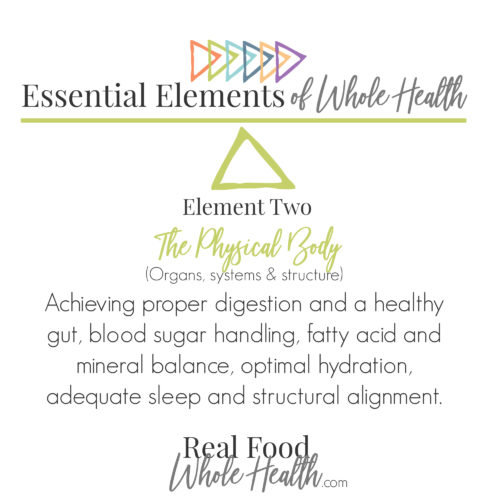
This article is the third in a series of posts exploring the Essential Six Elements of Whole Health, the core of our health philosophy and the foundation for our work with our nutritional therapy clients.
This article is divided into three parts. Read Part One and Part Two. Learn more about the Essential Elements and find the rest of the series here.
Part Three
Hydration is a topic we’ve covered in depth before and we’ll cover it again quickly here because water is the NUMBER ONE nutrient deficiency in America. People just simply aren’t drinking enough water and most of us are walking around chronically dehydrated.
 The rule of thumb is to drink HALF your body weight, in ounces, of clean, pure, filtered (and preferably room-temperature) water each and every day.
The rule of thumb is to drink HALF your body weight, in ounces, of clean, pure, filtered (and preferably room-temperature) water each and every day.
In addition to this amount, additional water should be consumed during periods of high activity (exercise) and for each diuretic (dehydrating) beverage, like coffee, caffeinated tea, soft drinks and fruit juice, another one and one half glasses of water should be added to the total.
All in all, it’s best to not go over about a gallon of water (regardless of weight or diuretic intake) because that can strain the kidneys.
Most Americans are drinking 1-2 glasses of water per day at most and instead subsist on sodas, coffee, processed juice beverages and other high sugar (and high chemical) beverages.
There are better choices for sure! The body can only make about 8% of its daily water needs through metabolic processes, the remaining 92% must be ingested daily!
So what exactly does water do for the body?
It flushes wastes, removes toxins, regulates body temperature, lubricates joints, transports nutrients, improves oxygen delivery to cells, enables cellular hydration, moistens oxygen for easier breathing, cushions bones and joints (and absorbs shocks to joints and organs), prevents tissues from sticking, improves cell-to-cell communication, maintains normal electrical properties of the cell and empowers the body’s natural healing process, just to name a few roles.
What problems are caused by dehydration? I recommend reading the book “Your Body’s Many Cries for Water” by Dr. Batmanghelidj for a full explanation, but the early signs of dehydration include fatigue, anxiety, irritability, depression, cravings, cramps and headache. (These are just the EARLY signs!)
Mature signs of dehydration include heartburn, joint pain, back pain, migraines, fibromyalgia, colitis and constipation.
So imagine how healthy you can become if you simply drink the appropriate amount of water daily!
Getting proper sleep is so important to our health and yet most of us don’t get near enough.
 The amount of sleep that your body needs is bioindividual, meaning that it won’t be the same for everyone, but somewhere in the neighborhood of 8-9 hours is generally a good target to aim for.
The amount of sleep that your body needs is bioindividual, meaning that it won’t be the same for everyone, but somewhere in the neighborhood of 8-9 hours is generally a good target to aim for.
Going to bed and waking up at roughly the same time each day is also a good idea, as it regulates your circadian rhythm, or body clock.
Sleeping in a dark room is advised, and avoiding bright lights and blue colored lights (like TV, computer screens, mobile phone screens, etc) in the evening hours is helpful in getting a good night’s rest.
Sleep influences multiple processes in the body, including blood sugar regulation, and plays a role in metabolism. During sleep is when we recover and rebuild, both of which are essential for healing.
Several of the foundations, like blood sugar handling and digestion, are also major contributors to insomnia, with people waking up in the middle of the night due to low blood sugar or heartburn (which most often is due to hypochlorhydria, or not having ENOUGH stomach acid!), so it’s important to address all of the issues here to avoid a vicious cycle of dysfunction that leads to insomnia, and insomnia that leads to further dysfunction.
 The final component of The Physical Body Essential Element is one that is slightly outside of my scope of practice as a nutritional therapist and one more suited to a highly skilled chiropractor.
The final component of The Physical Body Essential Element is one that is slightly outside of my scope of practice as a nutritional therapist and one more suited to a highly skilled chiropractor.
However, I will stress that proper structural alignment is crucial to overall health, and that many times full healing can not occur without addressing this piece of the puzzle.
Subluxations in the spine can have far-reaching consequences, with effects on the organs, nervous system, muscles and posture. I work with several chiropractors and their patients because nutrition and spinal care go hand-in-hand.
Sometimes people are unable to maintain manipulative correction (adjustments) and very often this can be tied to adrenal fatigue, usually secondary to blood sugar handling problems.
So we work to address this imbalance through dietary change and by supporting the organs of blood sugar handling, namely the adrenals in this case.
Sometimes I have a client that simply plateaus in their healing and after visiting an appropriate chiropractor, they make massive progress in a short time.
Chiropractic care is certainly something we support and encourage, as long as the chiropractor is highly skilled and not just a rack-em-and-crack-em style doctor that treats each patient the same no matter their symptoms.
A good chiropractor will address your body’s needs each and every time you visit them and generally has a wide knowledge of different adjustment techniques and modalities to suit your needs.
Healing the body is like uncovering layers of an onion.
It can seem complex, and sometimes it is, but by addressing the foundations and root causes of dysfunction, progress can happen swiftly in most cases.
Because of the interconnectedness of the body, a holistic mindset- one that addresses the body as a whole- is really the only way to approach true healing, in my opinion. In this way, the Essential Elements Method addresses each piece of the wellness puzzle, with The Physical Body being a huge factor in whole health.
Look for the next installment in the Essential Element series where we talk about a Non-Toxic Lifestyle.


Comments are closed.